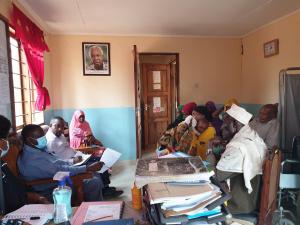Breaking the chain of Leprosy through community volunteers
Leprosy is an infectious disease that predominantly affects the skin and peripheral nerves. Untreated, it can cause progressive and permanent damage to the skin, nerves, limbs, and eyes. Leprosy is curable with multidrug therapy (MDT) made available through persistent efforts of national and subnational coordinators, researchers, partners and donors in the country.
In addressing and executing the promising gains of reducing the global burden on leprosy, the new WHO Global Leprosy Strategy 2021–2030, aims to halt disease transmission and reach zero leprosy cases. The Strategy urges governments to build "zero-leprosy roadmaps" that promotes novel ways such as focused active case identification and chemoprophylaxis to all confirmed contacts, to halt household and focal transmission in communities.
Devised and agreed upon by all stakeholders, the new strategy is projected to accelerate and sustain successes already observed in leprosy-endemic countries, thereby contributing towards achieving targets of the WHO Roadmap for Neglected Tropical Diseases 2021–2030, and the Sustainable Development Goal targets.
Tanzania attained the national elimination criterion of one leprosy case per 10,000 population in 2016. At least 13 of its districts (sub-national), however, the country continues to record instances above this threshold, making Tanzania one of six countries in the African region to report over 1,000 cases in a year.
With support from the Nippon Sasakawa Foundation, a three-year Bangkok Declaration Special Funds (BDSF) Project is being implemented in high burdened districts of Mkinga, Muheza Tanga region, and Chato district in Geita region, since May 2016. The aim is to break the chain of leprosy transmission among household members through timely detection and treatment completion for leprosy patients, as well as to reduce the number of grade two disability patients reporting as new leprosy cases at the time of diagnosis.
With technical support from the WHO and partners, at least 90 community volunteers were recruited by the National TB and Leprosy Programme, under the Ministry of Health, and beneficiary regions and districts under President’s Office, Regional Administration and Local Government Authorities, to undertake house-to-house contact screening for index leprosy cases, and to refer suspects to facilities for early diagnosis and treatment. Additionally, leprosy surveillance and evaluation systems were strengthened to ensure the effective and timely gathering of high-quality data for action and reporting.
Late in November 2021, the WHO team evaluated performance of the project in two districts of Tanga, alongside development of a leprosy roadmap 2022 – 2030 spearheaded by the Global Partnership for Zero Leprosy (GPZL). Preliminary findings from interviews with health personnel and community members in BDSF beneficiary districts, indicated early evidence of increased understanding and decreased stigma on leprosy, when compared to centuries-old misconceptions and beliefs deeply ingrained in affected societies. Unlike in non-beneficiary districts, the benefits of active case tracing were evident, as more cases were promptly directed to treatment facilities.
The Government has embraced the BDSF project's favorable findings by including active/contact tracing into the new national strategy for tuberculosis and leprosy control, as well as in training manuals and other guidelines. In collaboration with other partners, Tanzania's government has also launched trials on administering single dose rifampicin as chemoprophylaxis for contacts via skin encampment (blanket approach) in high-risk population in six high-burden districts. Additional resources are therefore necessary to support the scale up of these promising initiatives in the country. BDSF project evaluation was key to document its contribution to leprosy elimination in Tanzania, and on its potential for scalability.
The leprosy national review and BDSF evaluation, enabled GPZL partners, WHO and the Government to develop a national leprosy road map. In addition to the BDSF project, WHO provides free MDT, which is currently donated through Novartis.




